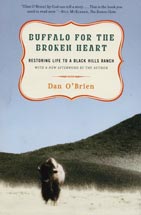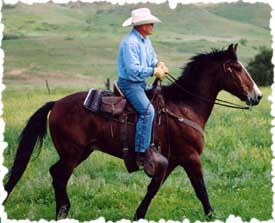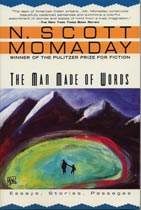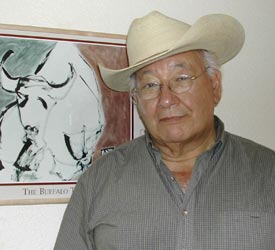
| Lane Home Page | Search Lane |
| Contact RT | Website Accessibility |

| Event Scrapbook | ||
| Evaluations | ||
| About Reading Together | ||
| Reading Together in Past Years | ||
| Contact Us | ||
| Reading Togther Main Page | ||
Reading Together 2006-07
Books | News | Calendar | Scrapbook | Faculty | Students
2006-2007 Books:
Buffalo For the Broken Heart: Restoring Life to a Black Hills Ranch

by Dan O'Brien
In this richly layered memoir of transformation, Dan O’Brien struggles to take charge of a life which for him has turned sour, as he finds himself inhabiting a territory of personal, economic, and ecological despair. And once he starts to act, several risky but potential-filled choices result in surprising effect: buffalo displace cattle; springs return to over-grazed, compacted rangeland; native plant species –their seeds long dormant—sprout to reinvigorate worn-out pasture. O’Brien spins a gripping tale of recovery, of a man worn out by trying to cobble together a piecemeal life, who, step by often scary step, charts a way back to health. In doing so, he rediscovers a way of making choices and a way of being in place that might serve to sustain many of us. For these ways are not new; rather they constitute a return to living one’s life with a sense of relationship to one’s place that was and continues to be widely practiced by the indigenous inhabitants of our land. In this relationship, humans make choices that respect the roles and needs of all the constituent elements of that place, so that the health of a place, and the people who inhabit that place, might be sustained. For O’Brien, these choices are anchored in the demanding realities of his South Dakota Great Plains ranch, the Broken Heart, situated at the foot of the Black Hills. Finding a means to thrive depends on discovering strategies that successfully contend with a climate of extremes in temperature, precipitation, and ever-present wind. Where thriving depends on struggling out from the depression of divorce, contending with economic and personal losses, and negotiating comfort with risk.
O’Brien is, at heart, a storyteller, so that while Buffalo for the Broken Heart contends with these very large concerns, he never wavers from the fact that he has a powerful story to tell, one that covers the range of human emotions from despair to hope, from grief to joy. We read about the improbability of Curly Bill, the runt with the misshapen horn, managing to hold his own against the most massive bull of O’Brien’s growing buffalo herd. Initially, O’Brien, upon seeing Curly Bill’s charge, “wondered if I was witnessing a buffalo suicide.” And for those of us who have found ourselves in dark and challenging places, O’Brien’s story has something to tell us about how struggle can become transformative, can become reinvention, can lead us to ever- widening circles of wholeness.
Dan O’Brien

Dan O'Brien is an owner of the Cheyenne River Ranch just west of the Badlands National Park and North of the Pine Ridge Indian Reservation. He lives & shares his life on the ranch with his partner Jill Maguire, and their old friends Erney Hersman & Gervase Hittle. Dan also continues to manage the Broken Heart Ranch, which is in the shadow of Bear Butte for the new owners and friends Rolle & Ell Hill.
Dan has been a wildlife biologist and rancher for more than thirty years, and knows the boom and bust cycle of cattle ranching inside out. He is also one of the most celebrated falconers in America today. He was a prime mover in the restoration of peregrine falcons in the Rocky Mountains in the 1970s and 80s. Described by the New York Times as a writer with "a keen and poetic eye…" Dan is one of the most powerful literary voices on the Plains. His novels are, The Spirit of the Hills, In the Center of the Nation, Brendan Prairie, The Contract Surgeon and The Indian Agent. Dan's two-volume memoirs on falconry, The Rites of Autumn and Equinox, are an intimate and revealing exploration of his life-long search for wildness on the Plains. Dan's latest non-fiction book, Buffalo for the Broken Heart (Random House, September 2001), explores the history of his ranch and the conversion from beef to buffalo. Buffalo for the Broken Heart has also recently been purchased by Universal Studies for Edward Norton. A screenplay has been commissioned and a movie could be in the future.
Dan is a two-time winner of the National Endowment for the Arts individual artist's grant, a two time winner of the Western Heritage Award and a 2001 recipient of the Bush Creative Arts Fellowship.
Dan is currently working on his latest Novel "Stolen Horses". In addition to writing, Dan divides his time between, teaching ecology and writing, serves on the board of Wildlife Experiences and the Black Hills branch of TNC, working on the ranches, and running Wild Idea Buffalo Company.
Biography from Dan O'Brien's website: www.wildideabuffalo.com/index.html
The Man Made of Words: Essays, Stories, Passages

Even as a man well into his 60’s, when N. Scott Momaday hears Kiowa, the native language of his father, “the sound is like a warm wind that arises from my childhood. It is the music of memory.” Here is a writer who fully understands the power of the tools of his trade, who asserts that language is a defining component of human culture. “We exist in the element of language,” and true to his words, Momaday immerses himself in this element. “Language is the stuff of the imagination. The imagination is the creative aspect of language. . .It enables us to realize a reality beyond the ordinary.” As we journey through this book’s various essays, stories, and musings, we will likely find ourselves swept out of our ordinary world and our accompanying assumptions. We learn what it means to be truly “at home” as Momaday gives a lift to “a young Navajo hitchhiker” who, in response to Momaday’s constant question, “Ei hash hoolye” (“’What is the name of that place’ or ‘What is that place called’”) answers with the name of every place they pass: “’Tse Awa’e’” (“’Rock babies’”), “’To Dineeshzhee’” (“’Water fanning out, water spreading in rivulets’”). As Momaday states, “I am interested in the way that a man looks at a given landscape and takes possession of it in his blood and brain.”
And we hear stories. The Kiowa brother, who, in order to save his brother from his Ute captors, fulfills his bargain to “walk upon a row of greased buffalo heads without falling to the ground” while carrying his brother on his back. And contemporary stories: Momaday’s climb up to the Medicine Wheel in Montana/Wyoming’s Bighorn Mountains, as he retraces the migration route of his Kiowa ancestors. He and his friend Chuck encounter Jurg, a young Swiss traveler driving “a very old Volkswagen bus, in much need of repair,” and together they climb to the ring of stones, some fifty feet in diameter.” Momaday describes the sacredness of their encounter: the “great calm,” the “eagle whistle” given to him by his father that Momaday blows “in the four directions,” the appearance of a “coyote sauntering across the snow into a wall of trees.”
But we also hear stories of conflict, the conflict which arises when a culture with a very different set of values, a very different way of being in place, occupies the land of the original inhabitants. These stories, both historical and contemporary, recount and analyze specific incidents, as well as examine the psychology which drives these interactions. Momaday explores how we all might come to a place of respect, a place where we are able to learn from our different beliefs and traditions. And he chooses to tell these stories for Native Americans themselves, as they act to restore what has been decimated.
Momaday covers much ground in this book, as he examines the sacredness of oral tradition, the new worlds which open to him when he encounters new places and people. But above all, we journey with Momaday into the sacred, into wholeness , a journey fueled by his belief in the restorative power of language, which lies at the heart of this book.

N. Scott Momaday is a poet, novelist, playwright, storyteller, artist, and a professor of English and American literature. He is a Kiowa and a member of the renowned Kiowa Gourd Dance Society. Educated at the University of New Mexico and Stanford University, he holds an earned Ph.D. and is presently Regents’ Professor of the Humanities at the University of Arizona. He has received the Pulitzer Prize (for House Made of Dawn), a Guggenheim Fellowship, numerous honorary degrees, and is a Fellow of the American Academy of Arts and Sciences. His books have been translated into French, German, Italian, Russian, Japanese, and Spanish, and include, in addition to House Made of Dawn, The Way to Rainy Mountain, Angle of Geese, The Gourd Dancer, The Names, The Ancient Child, In the Presence of the Sun, The Man Made of Words, In the Bear’s House, and Circle of Wonder. His articles have appeared in numerous periodicals, and he has lectured and given readings both here and abroad. In addition to creating the Buffalo Trust, he was a founding Trustee of the National Museum of the American Indian, and sits on the Boards of First Nations Development Institute and the School of American Research.
--bio and photo from www.buffalotrust.org.
Lane Community College - Reading Together |
